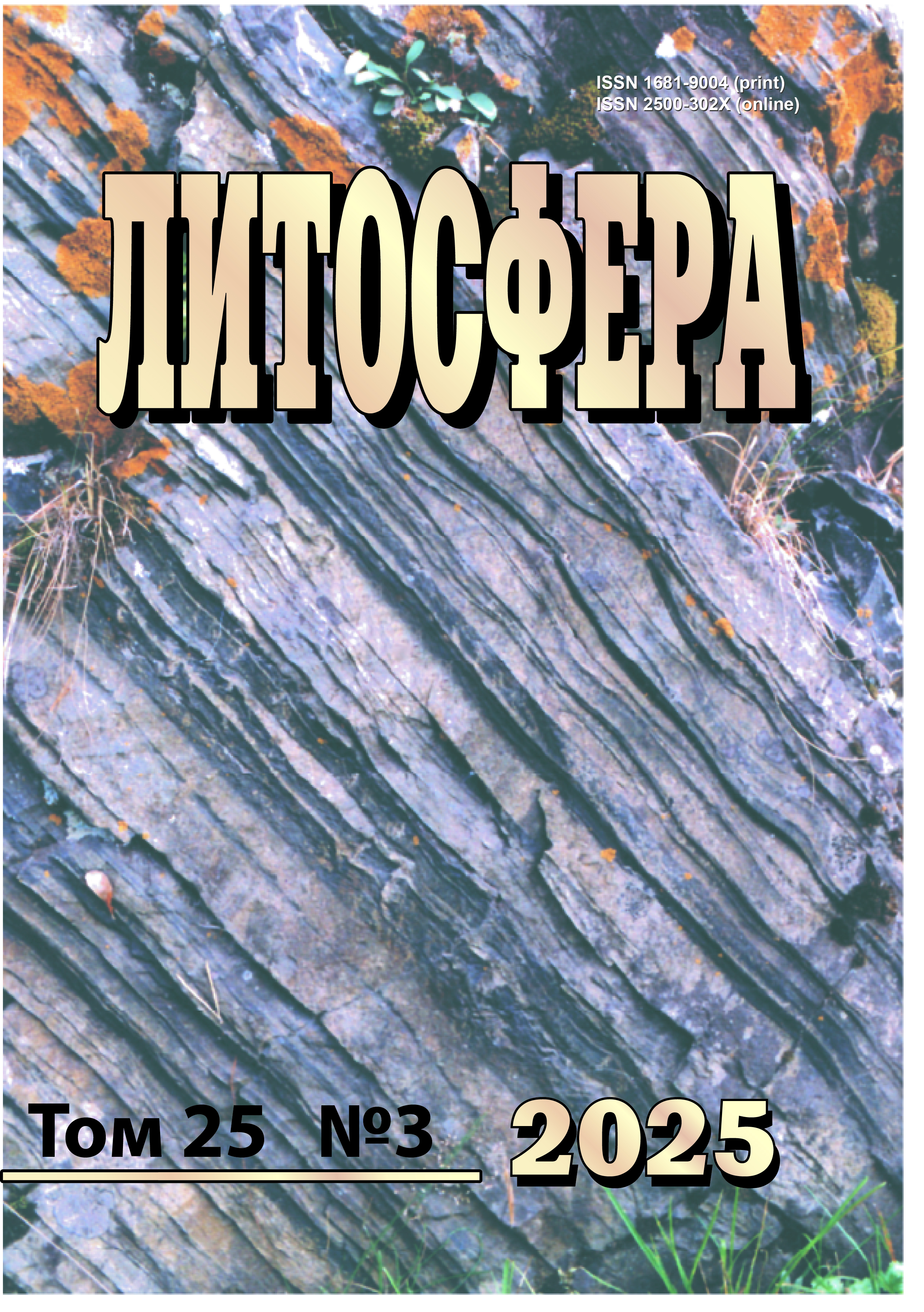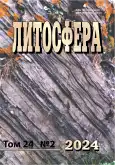Синтез кристаллов сульфидных минералов инконгруэнтными методами на примере систем Cu–Fe–S и Cu–Fe–Se
- Авторы: Пузанова И.Г.1,2, Панкрушина Е.А.3,4, Печурин М.С.3, Чареев Д.А.2,5,4,6
-
Учреждения:
- Университет науки и технологий МИСИС
- Институт экспериментальной минералогии им. академика Д.С. Коржинского РАН
- Институт геологии и геохимии им. академика А.Н. Заварицкого УрО РАН
- Физико-технологический институт Уральского федерального университета
- Государственный университет “Дубна”
- Казанский (Приволжский) федеральный университет
- Выпуск: Том 24, № 2 (2024)
- Страницы: 406-415
- Раздел: Статьи
- URL: https://journal-vniispk.ru/1681-9004/article/view/311196
- DOI: https://doi.org/10.24930/1681-9004-2024-24-2-406-415
- ID: 311196
Цитировать
Полный текст
Аннотация
Ключевые слова
Об авторах
И. Г. Пузанова
Университет науки и технологий МИСИС; Институт экспериментальной минералогии им. академика Д.С. Коржинского РАН
Email: air4a@yandex.ru
Е. А. Панкрушина
Институт геологии и геохимии им. академика А.Н. Заварицкого УрО РАН; Физико-технологический институт Уральского федерального университета
М. С. Печурин
Институт геологии и геохимии им. академика А.Н. Заварицкого УрО РАН
Д. А. Чареев
Институт экспериментальной минералогии им. академика Д.С. Коржинского РАН; Государственный университет “Дубна”; Физико-технологический институт Уральского федерального университета; Казанский (Приволжский) федеральный университет
Список литературы
- База данных Springer Materials: https://materials.springer.com
- Вильке К.-Т. (1977) Выращивание кристаллов (Ред. Т.Г. Петров, О.Ю. Пунин). Л.: Недра, 600 с.
- Тимофеева В.А. (1978) Рост кристаллов из растворов расплавов. M.: Наука, 266 с.
- Bernardini G.P., Corsini F., Mazzetti G., Trosti-Ferroni R. (1982) Phase relations in the CuFeSe system at 300°C. Mat. Res. Bull., 17(8), 981-991.
- Böhmer A.E., Taufour V., Straszheim W.E., Wolf T., Canfield P.C. (2016) Variation of transition temperatures and residual resistivity ratio in vapor-grown FeSe. Phys. Rev. B, 94(2), 024526.
- Chandra U., Singh N., Sharma P., Parthasarathy G. (2011) High‐Pressure Studies on Synthetic Orthorhombic Cubanite (CuFe2S3). AIP Conf. Proceed. Amer. Inst. Phys., 1349(1), 143-144.
- Chareev D.A., Volkova O.S., Geringer N.V., Evstigneeva P.V., Zgurskiy N.A., Koshelev A.V., Nekrasov A.N., Osadchii V.O., Filimonova O.N. (2019) The Synthesis of Crystals of Chalcogenides of K, Zr, Hf, Hg, and Some Other Elements in Halide Melts under Conditions of Stationary Temperature Gradient. Cryst. Rep., 64, 996-1002.
- Chareev D.A. (2016) General principles of the synthesis of chalcogenides and pnictides in salt melts using a steady-state temperature gradient. Cryst. Rep., 61(3), 506-511.
- Chareev D.A., Volkova O.S., Geringer N.V., Koshelev A.V., Nekrasov A.N., Osadchii V.O., Osadchii E.G., Filimonova O.N. (2016) Synthesis of chalcogenides and pnictides in salt melts using a steady-state temperature gradient. Cryst. Rep., 61(4), 682-691.
- Feiguin A.E. et al. (2019) Quantum liquid with strong orbital fluctuations: the case of a pyroxene family. Phys. Rev. Lett., 123(23), 237204.
- Greenwood N.N., Whitfield H.J. (1968) Mössbauer effect studies on cubanite (CuFe2S3) and related iron sulphides. J. Chem. Soc. A: Inorgan., Phys., Theor., 1697-1699.
- Hamdadou N. et al. (2006) Fabrication of n-and p-type doped CuFeSe2 thin films achieved by selenization of metal precursors. J. Phys. D: Appl. Phys., 39(6), 1042.
- Imbert P., Wintenberger M. (1967) Étude des propriétés magnétiques et des spectres d’absorption par effet Mössbauer de la cubanite et de la sternbergite. Bulletin de Minéralogie, 90(3), 299-303.
- Iordanidis A., Garcia-Guinea J., Strati A., Gkimourtzina A. (2013) Gold gilding and pigment identification on a post-byzantine icon from Kastoria, Northern Greece. Analyt. Lett., 46(6), 936-945.
- Jackeli G., Khaliullin G. (2009) Magnetically Hidden Order of Kramers Doublets in d 1 Systems: Sr2VO4. Phys. Rev. Lett., 103(6), 067205.
- Jaimes E., Gonzalez-Jimenez F., D’Onofrio L., Iraldi R., Quintero M., Gonzalez J. et al. (1994) Evidence for the existence of two electronic states in the chalcopyrite-type alloys CuFe(S1−zSez)2. Hyperfine Interact., 91, 607-612.
- Khomskii D.I., Streltsov S.V. (2020) Orbital effects in solids: Basics, recent progress, and opportunities. Chem. Rev., 121(5), 2992-3030.
- Liu H., Khaliullin G. (2018) Pseudospin exchange interactions in d 7 cobalt compounds: Possible realization of the Kitaev model. Phys. Rev. B., 97(1), 014407.
- Ma M., Ruan B., Zhou M., Gu Y., Dong Q., Yang Q., Wang Q., Chen L, Shi Y., Yi J., Chen J., Ren Z. (2023) Growth of millimeter-sized high-quality CuFeSe2 single crystals by the molten salt method and study of their semiconducting behavior. J. Cryst. Growth, 622, 127398.
- Makovicky E., Karup-Møller S. (2020) The central portions of the Cu-Fe-Se phase system at temperatures from 900 to 300°C. Canad. Miner., 58(2), 203-221.
- Merwin H.E., Lombard R.H. (1937) The system Cu-Fe-S. Econ. Geol., 32(2_Suppl), 203-284.
- Mikuła A., Koleżyński A. (2019) First principles studies of Fe-doped Cu2S–Theoretical investigation. Solid State Ionics, 334, 36-42.
- Pankrushina E.A., Votyakov S.L., Aksenov S.M., Komleva E.V., Uporova N.S., Vaitieva Y.A. (2023) In situ thermo‐Raman spectroscopy and ab initio vibrational assignment calculations of cubanite CuFe2S3. Raman Spectrosc., 54(7), 769.
- Pankrushina E.A., Ushakov A.V., Abd-Elmeguid M.M., treltsov S.V. (2022) Orbital-selective behavior in cubanite CuFe2S3. Phys. Rev. B, 105(2), 024406.
- Parker G.K., Woods R., Hope G.A. (2008) Raman investigation of chalcopyrite oxidation. Coll. Surf. A: Physicochem., Eng. Aspects, 318(1-3), 160-168.
- Polubotko A.M. (2011) Ferron-type conductivity in metallic CuFeSe2. The Phys. Metals Metallogr., 112, 589-590.
- Pruseth K.L., Mishra B., Bernhardt H.-J. (1999) An experimental study on cubanite irreversibility: implications for natural chalcopyrite-cubanite intergrowths. Eur. J. Mineral., 11(47), 471-476.
- Schafer H. (1962) Chemische Transportreaktionen.Weinhelm; Bergstr: Verlag Chemie, MnbH, 190 p.
- Sleight A.W., Gillson J.L. (1973) Electrical resistivity of cubanite: CuFe2S3. J. Solid State Chem., 8(1), 29-30.
- Solache-Carranco H. et al. (2009) Photoluminescence and X-ray diffraction studies on Cu2O. J. Luminesc., 129(12), 1483-1487.
Дополнительные файлы









